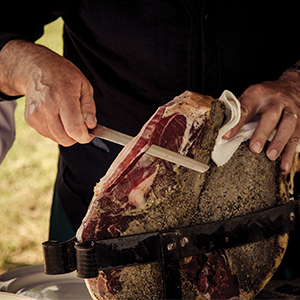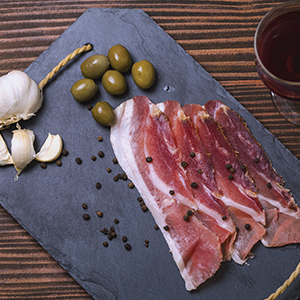Prosciutto di Toscano translates literally to ham from Tuscany and incorporates a large number of different products both raw and cooked. However, Prosciutto di Toscano DOP (or PDO in English) expresses a very special style of ham made in Tuscany. Dry-cured, it is not as widely known as Prosciutto di Parma and San Daniele in the United States. Only recently imported, it is making an appearance in specialty retailers from small shops to larger chains.
While everyone has their favorite, Prosciutto di Toscano is quite distinctive. Unlike both Prosciutto di Parma and San Daniele, which are made from slightly larger legs of ham and cured only with sea salt, prosciutto from the hills of Tuscany is slightly different and has its own dedicated followers.
Produced since the 15th century and standardized in production since it was recognized as a PDO, it’s made with a blend of spices that include black pepper, garlic, rosemary and wild juniper berries. Cured for a minimum of 12 to 16 months, this Tuscan variety has a darker pink fat and the taste is definitley a bit more concentrated and spicier.
The History and Evolution
Pig farming has always been extremely important in Tuscany, which has a long history of ancient, rural smallholdings. This has evolved and developed in terms of popularity and scale; however, it has always managed to maintain the connection to its roots. Because the animal legs are often smaller, this prosciutto type tends to be drier. Usually it is sliced into slightly thicker slices, so the flavor is bolder. A favorite accompaniment is the hard bread made without salt, a table staple in Tuscan households.
Around 1000 AD, the art of processing pig meat in the Tuscan region was consolidated, yet the laws regarding pig slaughtering and pork meat preservation can be traced all the way back to the time of Charlemagne.
There is text from this period, which describes the first rules of ham production, even though the real appearance of Prosciutto di Toscano came after the Renaissance.

The Back Story
Historically, Tuscan farmers would slaughter the pig they had reared and fattened for a year and transform it into salami and other charcuterie for family consumption, as opposed to producing the meat for commercial purposes. It was only around the 15th century, under the rule of the Medici, that Tuscan ham production started becoming regulated. From then on, it evolved into what it is today.
Prosciutto di Toscano is one of only a handful of Italian dry-cured hams to obtain its PDO status out of over 30 styles of dry-cured hams throughout Italy. This began with a group of producers in Tuscany realizing the need to distinguish and protect the traditions of Tuscan products, especially since it was clear that Prosciutto di Parma and San Danielle were commercially benefiting from their recognition as separate and protected products.
They created a consortium in 1990 and, in 1996, it received its PDO status. The PDO specifies that these hams must be processed in Tuscany, however the fresh meat can come from any of five surrounding areas. This includes Emilia-Romagna, Lombardy, Lazio, Marche and Umbria. The pigs must be at least nine months old before slaughtering and weigh between 144 and 176 kg (between 317 and 388 pounds). Included in its PDO requirements, the hams must be matured for a minimum of 12 months.
The Production
Once the pigs have reached nine months old or more, depending on the individual producer, they are slaughtered, butchered and salted. Only fresh, hind legs are permitted; they must not have been previously frozen or preserved in any other way.
Each leg is dry-salted with a mixture of salt and seasoning called ‘agliata’, that includes bay leaf, garlic, rosemary and juniper berries, which reflect typical aromas of its terroir. The salting process is critical, as too much will result in a salty ham and too little will cause the ham to perish prematurely.
The hams are left for three to four weeks to rest in refrigeration ‘il riposo’ before they are trimmed and dressed ‘la toletta’ and then left for another four months of drying ‘pre-stagionatura’. At this point, the hams start to take on their signature flavors and appearance. The open, trimmed side of the ham is smothered with ’sugna’, a mixture of lard, black pepper, salt and rice flour to prevent excess dehydration.
The hams must then be left to mature for a minimum of 12 months, in some cases up to 24 months, in a drying room at specific temperatures to promote the enzyme development that contributes to its flavor. The ham quality is checked by the ‘spiking’ method, which involves graders spiking the hams with a needle-shaped horse bone that they then check by scent.
PDO hams are finally marked with a branding iron, so they are unmistakeably Prosciutto di Toscano and cannot be passed as any other type. The brand also acts as a stamp of completion, confirming that all PDO production methods have been followed. The hams then get their final trademark pepper coating and are ready to be sold.
The final sliced ham is bright to pale red with very little fat and a complexity of aromas and flavors reminiscent of the region due to the seasoning.

The Pairing
The ham, being seasoned so heavily, goes well with Tuscany’s saltless bread. Bread in Tuscany has been made without salt since Roman times, so Tuscan cuisine typically has more salt added. Pickled vegetables are common at the table in Tuscany with vegetables either sott’olio (in oil) or sott’aceto (in vinegar) to cut through the richness of the ham.
Many enjoy the ham with artichokes and asparagus, soft cheeses, such as Ricotta, or a harder Pecorino Toscano. Sweet and salt are a marriage made in heaven, so either fresh figs or Fichi di Cosenza DOP are a great match.
As for wine, this is subjective, however, to stick with regionality you cannot go wrong with a glass of a Sangiovese-based wine, such as Chianti Classico DOCG or Brunello di Montalcino DOCG, originating in the Southern Tuscan hills. CC



